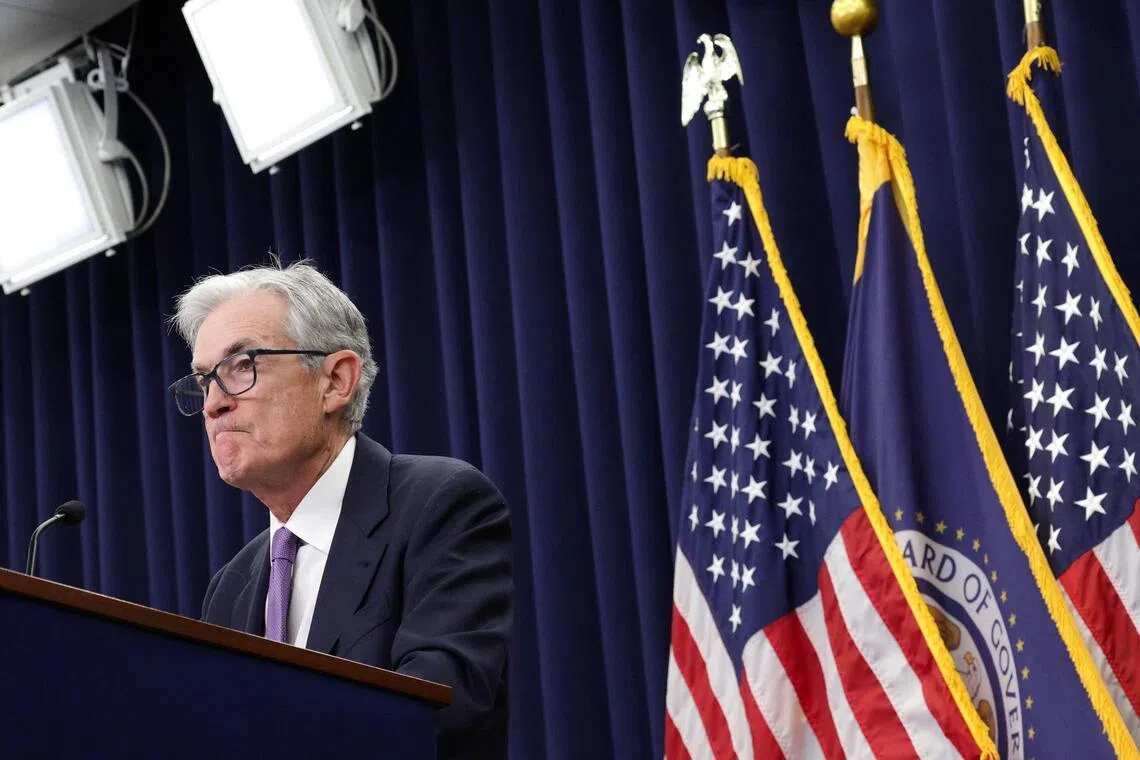Data ‘fog’ has some investors feeling for the exits as AI stock valuation fears flare
Sign up now: Get ST's newsletters delivered to your inbox

Federal Reserve chair Jerome Powell has likened the situation to “driving in the fog” and flagged that policymakers are likely to “slow down” in response.
PHOTO: AFP
Follow topic:
NEW YORK - The US shutdown has ended, but the hangover is just beginning for investors, who worry gaps in economic data will delay or even derail Federal Reserve rate cuts just as concerns over lofty AI stock valuations have put fresh pressure on companies’ stocks and bonds.
Unease drove the heaviest sell-off for the rate-sensitive Nasdaq in a month on Nov 13. The index, which has soared in 2025 with booming AI shares, is down about 4 per cent from October’s peak.
Pressure continued in early trade on Nov 14, with blue chip bourses from Tokyo to Paris and London deep in the red, but eased later in the day with the S&P 500 ending slightly lower and the Nasdaq Composite up 0.13 per cent. Even gold and Bitcoin were not spared, the latter hitting lows last seen in May.
Credit spreads – or the premium over US Treasuries paid by companies to issue bonds in the US market – widened earlier in November.
“The market certainly has some froth both in terms of valuations and expectations”, said Mr Michael McGowan, managing director of investment strategy at Pathstone. “I think there’s a healthy scepticism coming into the market and you could certainly see that continue to play out a little more,” he said.
The problem is being exacerbated by an information vacuum that ranges from futures positioning to crop estimates and in particular job and price figures, some of which were not collected during the 43 days of shutdown.
There is doubt about the publication of October’s inflation data and the employment report for that month will not include the jobless rate, White House economic adviser Kevin Hassett said, because the household survey from which it is calculated was not conducted.
On Nov 14, the Census Bureau and the Bureau of Labour Statistics announced they would begin releasing data skipped over during the shutdown starting next week. Employment data for September, which had been scheduled for release on Oct 3, will be published on Nov 20.
The gaps in the data matter for markets because Federal Reserve chair Jerome Powell has likened the situation to “driving in the fog” and flagged that policymakers are likely to “slow down” in response, or in other words hold rather than cut interest rates, after two consecutive cuts in September and October.
Mr Tim Horan, chief investment officer of fixed income at Chilton Trust, said: “We were able to see a September cut and an October cut because they felt confident in their direction of travel for inflation... Will they have that confidence at the December meeting with the lack of data points?”
Expectations for a 25-basis point rate cut in December, seen as a sure thing a month ago, are down to about 46 per cent, according to CME’s FedWatch tool.
“We’ve obviously had a huge rally in the market from the April trough, and it’s pretty much been uninterrupted,” said Mr Matt Sherwood, head of investment strategy at Perpetual in Sydney.
“(It) requires Fed rate cuts and sustained easy financial conditions to justify what I think are extreme valuations.”
The forward price-to-earnings ratio for the S&P 500, based on earnings estimates for the next 12 months, is currently around 22.8 times, well above its 10-year average of 18.8, according to LSEG Datastream.
Together with year-to-date gains above 20 per cent in hard-running sectors such as technology, it also does not take much for investors to want to lock in some gains. Already, the mood has turned fickle and darlings such as Palantir and Oracle have logged losses around 12 per cent and 14 per cent, respectively, in November. Chipmaker Nvidia is down 6 per cent.
Nvidia’s results next week are critical, given the stock has been at the fore of the record-breaking stock rally in 2025.
“We’re at a time of year here where any kind of downside might ripple a little bit further in certain sectors that have really put up big numbers this year, as you’re going to have some trigger fingers to take some profits off the table,” said Mr Chuck Carlson, chief executive officer at Horizon Investment Services in Hammond, Indiana.
Meanwhile, Mr Michael Burry’s decision to close his hedge fund Scion Asset Management on Nov 13 added to jitters over frothy AI valuations. He has argued that tech giants pouring billions into Nvidia chips and servers are quietly stretching out depreciation schedules to make earnings look smoother.
Valuation concerns spilled over into corporate debt markets, too. Bonds issued by Oracle Corp have taken a hit in recent days as concerns rise over the cloud and AI giant’s huge debt issuance to further fund its AI infrastructure.
Hedge funds disclosed their third-quarter positioning on Nov 14 with some showing possible bearishness on tech. Tiger Global Management, the hedge fund founded and led by Mr Chase Coleman, showed it slashed its stake in Facebook parent Meta Platforms.
During the shutdown, the data void shot previously little-followed private surveys to prominence and painted a mixed picture of the economy where spending appears to be holding up but, on some measures, layoffs have surged.
Investors have struggled to draw conclusions and have stuck with expectations for at least three cuts by the end of 2026 to take rates to about 3 per cent. Analysts say that view is likely to face pressure, especially as a growing number of policymakers are sounding reticent on rate cuts.
“The Fed is flying blind as we are,” said Mr Bob Savage, head of markets macro strategy at BNY in New York. BLOOMBERG

